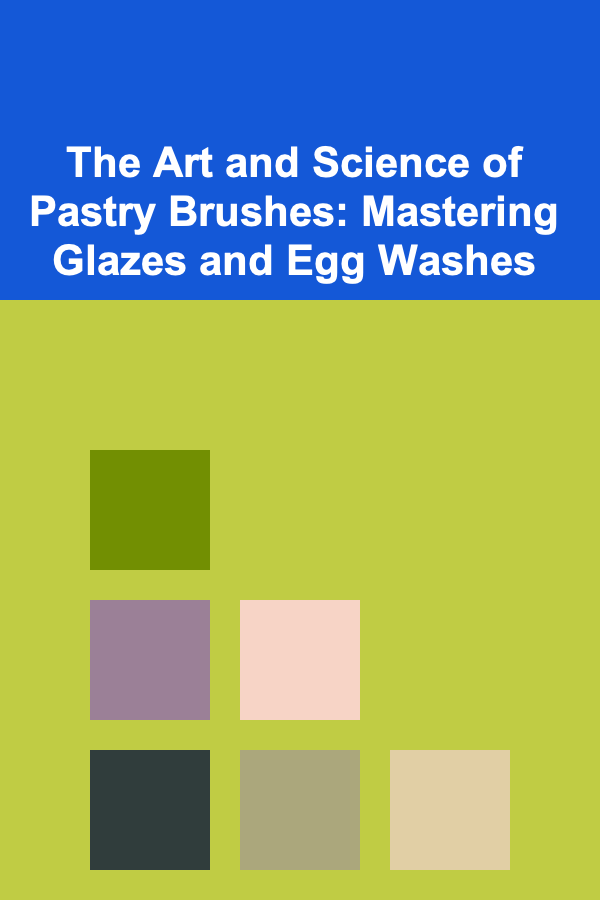
The Art and Science of Pastry Brushes: Mastering Glazes and Egg Washes
ebook include PDF & Audio bundle (Micro Guide)
$12.99$9.99
Limited Time Offer! Order within the next:

The humble pastry brush, often overlooked in the arsenal of baking tools, is a powerhouse when it comes to achieving professional-looking finishes on pastries, breads, and other baked goods. Its seemingly simple function -- applying liquids -- belies a nuanced art and a surprisingly significant impact on the final product. This article delves deep into the world of pastry brushes, exploring their types, proper usage techniques, cleaning methods, and troubleshooting tips to help you master the application of glazes and egg washes for truly exceptional results.
Understanding the Importance of Glazes and Egg Washes
Before diving into the intricacies of pastry brushes, it's crucial to understand why glazes and egg washes are so integral to baking. They are not mere decorative afterthoughts; they contribute significantly to the visual appeal, texture, and flavor of baked goods.
Glazes: Adding Sweetness, Shine, and Protection
Glazes are typically sweet mixtures applied to baked goods, often after baking, to add shine, flavor, and sometimes a protective layer. They can range from simple sugar glazes made with powdered sugar and liquid to more complex preparations involving fruit purees, chocolate, or even liquors.
Functions of Glazes:
- Visual Appeal: Glazes impart a glossy sheen, making baked goods more attractive and appetizing. The reflective surface catches the light, enhancing the overall presentation.
- Flavor Enhancement: Glazes add a layer of sweetness or complementary flavor to the baked good. This can be subtle, like a hint of vanilla, or bold, like a rich chocolate ganache.
- Moisture Retention: Some glazes, particularly those with a higher sugar content, can help to seal in moisture, preventing the baked good from drying out too quickly.
- Protection from Oxidation: A glaze can act as a barrier, protecting fruits and fillings from browning or drying out due to oxidation. This is especially important for fruit tarts and pies.
- Adhesion for Decorations: Glazes can act as a "glue" to hold sprinkles, nuts, or other decorations onto the surface of the baked good.
Egg Washes: Enhancing Color, Texture, and Crust
Egg washes, typically a mixture of eggs (whole, yolks, or whites) and sometimes a liquid like water or milk, are applied before baking to create a golden-brown, glossy crust. They also influence the texture of the crust, making it crispier or softer, depending on the specific mixture.
Functions of Egg Washes:
- Golden-Brown Color: The proteins and sugars in the egg react during baking to create a beautiful Maillard reaction, resulting in a rich, golden-brown color. The intensity of the color can be adjusted by varying the ratio of egg yolks to egg whites.
- Enhanced Shine: Egg washes create a glossy sheen on the surface of the baked good, making it visually appealing and professional-looking.
- Crust Texture: The type of egg wash used can significantly impact the crust's texture. Egg whites create a crispier crust, while egg yolks contribute to a softer, richer crust.
- Adhesion for Seeds and Toppings: Egg wash acts as an excellent adhesive for seeds, nuts, and other toppings, ensuring they adhere securely to the dough during baking.
- Sealing Properties: The protein in the egg wash coagulates during baking, creating a thin barrier that can help to prevent fillings from seeping out of pies or pastries.
Types of Pastry Brushes: A Comprehensive Guide
The choice of pastry brush is crucial for achieving the desired result. Different brush types are suited for different tasks and produce varying textures and finishes. Understanding the nuances of each type allows you to select the best tool for the job.
Bristle Brushes: The Traditional Choice
Bristle brushes are the traditional choice for applying glazes and egg washes. They are typically made from natural animal hair, such as boar or hog bristle.
Pros of Bristle Brushes:
- Excellent Liquid Retention: Bristle brushes hold a significant amount of liquid, allowing for efficient and even application.
- Natural Texture: The natural texture of the bristles helps to distribute liquids evenly and prevent streaks or pooling.
- Durable: High-quality bristle brushes can last for many years with proper care.
Cons of Bristle Brushes:
- Shedding: Bristle brushes can shed hairs, which can be frustrating and potentially contaminate your baked goods. Look for brushes with tightly bound bristles to minimize shedding.
- Difficult to Clean: The porous nature of natural bristles makes them more difficult to clean thoroughly, and they can retain odors and flavors.
- Can Be More Expensive: High-quality bristle brushes tend to be more expensive than synthetic alternatives.
Silicone Brushes: The Modern Alternative
Silicone brushes have become increasingly popular in recent years due to their ease of use and maintenance. They are made from food-grade silicone and are available in a variety of shapes and sizes.
Pros of Silicone Brushes:
- Heat Resistant: Silicone brushes can withstand high temperatures, making them suitable for use with hot glazes and even for basting in the oven.
- Easy to Clean: Silicone is non-porous and easy to clean with soap and water. They are also dishwasher safe.
- Hygienic: Silicone doesn't harbor bacteria or odors, making it a more hygienic option than bristle brushes.
- No Shedding: Silicone brushes don't shed bristles, eliminating the risk of contamination.
- Affordable: Silicone brushes are generally less expensive than high-quality bristle brushes.
Cons of Silicone Brushes:
- Less Liquid Retention: Silicone brushes don't hold as much liquid as bristle brushes, requiring more frequent dipping.
- Can Be Less Precise: The stiffness of silicone bristles can sometimes make it difficult to achieve a smooth, even application, especially on delicate surfaces.
Other Brush Types: Specialty Tools
While bristle and silicone brushes are the most common, other specialized brushes are available for specific tasks.
- Fanned Pastry Brushes: These brushes have a wide, fanned shape, ideal for applying egg washes to large surfaces quickly and evenly. They are particularly useful for pastry sheets and large loaves of bread.
- Round Pastry Brushes: These brushes have a rounded head and are excellent for applying glazes to intricate pastries or for detail work.
Choosing the Right Brush:
Consider the following factors when choosing a pastry brush:
- The type of liquid you will be applying: Thicker glazes may require a stiffer brush, while thinner egg washes are best applied with a softer brush.
- The size and shape of the baked good: Larger surfaces require wider brushes, while intricate shapes require smaller, more precise brushes.
- Your personal preference: Experiment with different brush types to find one that you feel comfortable using and that produces the desired results.
Mastering the Technique: Applying Glazes and Egg Washes Like a Pro
Having the right brush is only half the battle. Proper technique is essential for achieving a flawless finish. The following tips will help you master the art of applying glazes and egg washes.
Preparing Your Glaze or Egg Wash
The consistency and temperature of your glaze or egg wash are crucial for optimal application.
Glazes:
- Consistency: The glaze should be thin enough to spread easily but thick enough to adhere to the baked good without running off excessively. Adjust the consistency by adding more liquid (for a thinner glaze) or more powdered sugar (for a thicker glaze).
- Temperature: Ideally, glazes should be applied warm. This helps them flow smoothly and adhere evenly. If the glaze has cooled and thickened, gently reheat it in the microwave or over a double boiler.
Egg Washes:
- Preparation: Whisk the egg(s) and liquid (if using) together thoroughly until the mixture is smooth and slightly frothy. This ensures even distribution of the proteins and sugars.
- Straining (Optional): For an ultra-smooth finish, strain the egg wash through a fine-mesh sieve to remove any chalazae (the white cords attached to the yolk) or bits of shell.
- Resting: Allowing the egg wash to rest for a few minutes before applying can help to reduce bubbles and improve the shine.
Applying the Glaze or Egg Wash: Step-by-Step
- Dip Sparingly: Avoid overloading the brush with liquid. Dip only the tips of the bristles or silicone nubs into the glaze or egg wash. This will prevent drips and ensure a more even application.
- Apply Lightly: Use a light, even touch to apply the glaze or egg wash. Avoid pressing down too hard, as this can distort the shape of the baked good or create unwanted brushstrokes.
- Overlap Strokes: Overlap each stroke slightly to ensure complete coverage and prevent gaps.
- Work in One Direction: For a smoother finish, try to apply the glaze or egg wash in one direction. Avoid going back and forth repeatedly, as this can create a streaky or uneven appearance.
- Avoid Pooling: Pay attention to areas where liquid might pool, such as crevices or corners. Use the tip of the brush to gently spread out any excess liquid.
- For Egg Washes: If applying seeds or toppings, do so immediately after brushing with the egg wash, while it is still wet. This will ensure the toppings adhere properly.
- Multiple Coats (Optional): For a richer color or a thicker glaze, apply multiple thin coats, allowing each coat to dry slightly before applying the next.
Specific Techniques for Different Baked Goods
- Breads and Rolls: Apply egg wash liberally to the entire surface of the dough, paying particular attention to the edges. A fanned pastry brush is ideal for this task.
- Pies and Tarts: For pies, apply egg wash to the top crust to promote browning and create a beautiful sheen. Be careful not to drip egg wash onto the filling, as this can prevent the crust from sealing properly. For tarts, apply glaze after baking to protect the fruit and add shine.
- Pastries: For delicate pastries, use a light touch and a smaller brush to avoid damaging the surface. Apply glaze or egg wash sparingly to achieve a subtle sheen.
- Cookies: Apply glaze to cookies after they have cooled completely. Use a small brush or even a dipping technique for intricate designs.
Troubleshooting: Common Problems and Solutions
Even with the best techniques, occasional problems can arise when applying glazes and egg washes. Here are some common issues and their solutions:
- Streaky or Uneven Application:
- Cause: Uneven pressure, too much liquid on the brush, or a brush that is not distributing the liquid evenly.
- Solution: Use a lighter touch, dip the brush sparingly, and ensure that the brush is clean and in good condition. Try using a different brush type.
- Pooling of Liquid:
- Cause: Too much liquid applied, or the glaze or egg wash is too thin.
- Solution: Apply less liquid and ensure the consistency of the glaze or egg wash is appropriate. Use the tip of the brush to spread out any excess liquid.
- Dark Spots or Uneven Browning (Egg Wash):
- Cause: Uneven application of the egg wash, or excessive sugar in the egg wash.
- Solution: Apply the egg wash evenly and avoid adding too much sugar. Consider using a mixture of egg white and water for a lighter browning effect.
- Shedding Bristles:
- Cause: A low-quality bristle brush or a brush that is not properly cared for.
- Solution: Invest in a high-quality bristle brush and clean it properly after each use. If the brush continues to shed, consider switching to a silicone brush.
- Glaze Not Adhering Properly:
- Cause: The baked good is too hot or too oily, or the glaze is too thin.
- Solution: Allow the baked good to cool slightly before applying the glaze. Ensure that the surface is not overly oily. Thicken the glaze by adding more powdered sugar.
Caring for Your Pastry Brushes: Maintenance and Cleaning
Proper care and maintenance are essential for extending the life of your pastry brushes and ensuring they perform optimally. Here's how to keep your brushes in top condition:
Cleaning Bristle Brushes:
- Rinse Immediately: After each use, rinse the brush immediately under warm running water to remove any excess glaze or egg wash.
- Wash with Soap: Wash the brush with warm, soapy water, gently working the bristles to remove any remaining residue.
- Rinse Thoroughly: Rinse the brush thoroughly under warm running water until all traces of soap are gone.
- Shake Out Excess Water: Shake out as much excess water as possible.
- Dry Properly: Allow the brush to air dry completely, bristle-side down. This will prevent water from collecting in the ferrule (the metal part that holds the bristles) and causing the bristles to loosen or fall out. You can use a brush stand or simply lay the brush on a clean towel with the bristles hanging over the edge.
- Condition (Optional): Occasionally, you can condition the bristles with a small amount of vegetable oil to keep them soft and supple.
Cleaning Silicone Brushes:
Silicone brushes are much easier to clean than bristle brushes.
- Rinse Immediately: After each use, rinse the brush immediately under warm running water.
- Wash with Soap: Wash the brush with warm, soapy water.
- Rinse Thoroughly: Rinse the brush thoroughly under warm running water.
- Shake Out Excess Water: Shake out as much excess water as possible.
- Dry Properly: Allow the brush to air dry completely. Silicone brushes can be dried bristle-side up or down.
- Dishwasher Safe: Most silicone brushes are dishwasher safe, making cleaning even easier.
Storage:
Store pastry brushes in a clean, dry place, away from direct sunlight or heat. Avoid storing them in a drawer with other utensils, as this can damage the bristles or silicone nubs. A brush stand or a dedicated utensil holder is ideal.
Replacing Your Brush:
Even with proper care, pastry brushes will eventually wear out. Replace your brush when the bristles become frayed, loose, or excessively stained, or when the silicone nubs begin to crack or break.
Beyond the Basics: Advanced Techniques and Tips
Once you've mastered the fundamental techniques, you can explore more advanced applications of pastry brushes for even more impressive results.
- Creating Decorative Patterns: Use a pastry brush to create decorative patterns on the surface of dough before baking. For example, you can brush parallel lines or a criss-cross pattern with egg wash to create a visually appealing crust.
- Applying Edible Glue: Use a small pastry brush to apply edible glue (such as royal icing or thinned apricot jam) to attach decorations to cakes, cookies, or pastries.
- Oiling Pans: A pastry brush can be used to evenly oil baking pans, ensuring that baked goods release easily.
- Basting Meats: While technically a pastry brush, it can be used to baste meats with sauces or marinades during roasting or grilling. Just be sure to use a separate brush for this purpose and clean it thoroughly after each use.
- Creating a "Sugar Crust" on Bread: After applying an egg wash to bread dough, sprinkle with coarse sugar (such as pearl sugar or sanding sugar). The sugar will adhere to the egg wash and create a sweet, crunchy crust.
Tip: Experiment with different brush types, glazes, and egg washes to find what works best for you. Don't be afraid to try new techniques and explore your creativity. Baking is both a science and an art, and the pastry brush is a valuable tool for both.
Conclusion: The Versatile Pastry Brush
The pastry brush, though seemingly simple, is a remarkably versatile tool that can elevate your baking from ordinary to extraordinary. By understanding the different types of brushes, mastering the proper techniques for applying glazes and egg washes, and practicing good care and maintenance, you can unlock the full potential of this essential baking tool and create truly beautiful and delicious baked goods.

How to Make a Budget That Works for Your Family's Needs
Read More
How to Use Decorative Trunks for Stylish Storage
Read More
How To Understand the Philosophy of Information
Read More
How To Understand Large-Scale 3D Printing Methods
Read More
How To Choose the Right Eye Cream for Your Concerns
Read More
10 Tips for Measuring the ROI of Your Leadership Development Planner
Read MoreOther Products

How to Make a Budget That Works for Your Family's Needs
Read More
How to Use Decorative Trunks for Stylish Storage
Read More
How To Understand the Philosophy of Information
Read More
How To Understand Large-Scale 3D Printing Methods
Read More
How To Choose the Right Eye Cream for Your Concerns
Read More